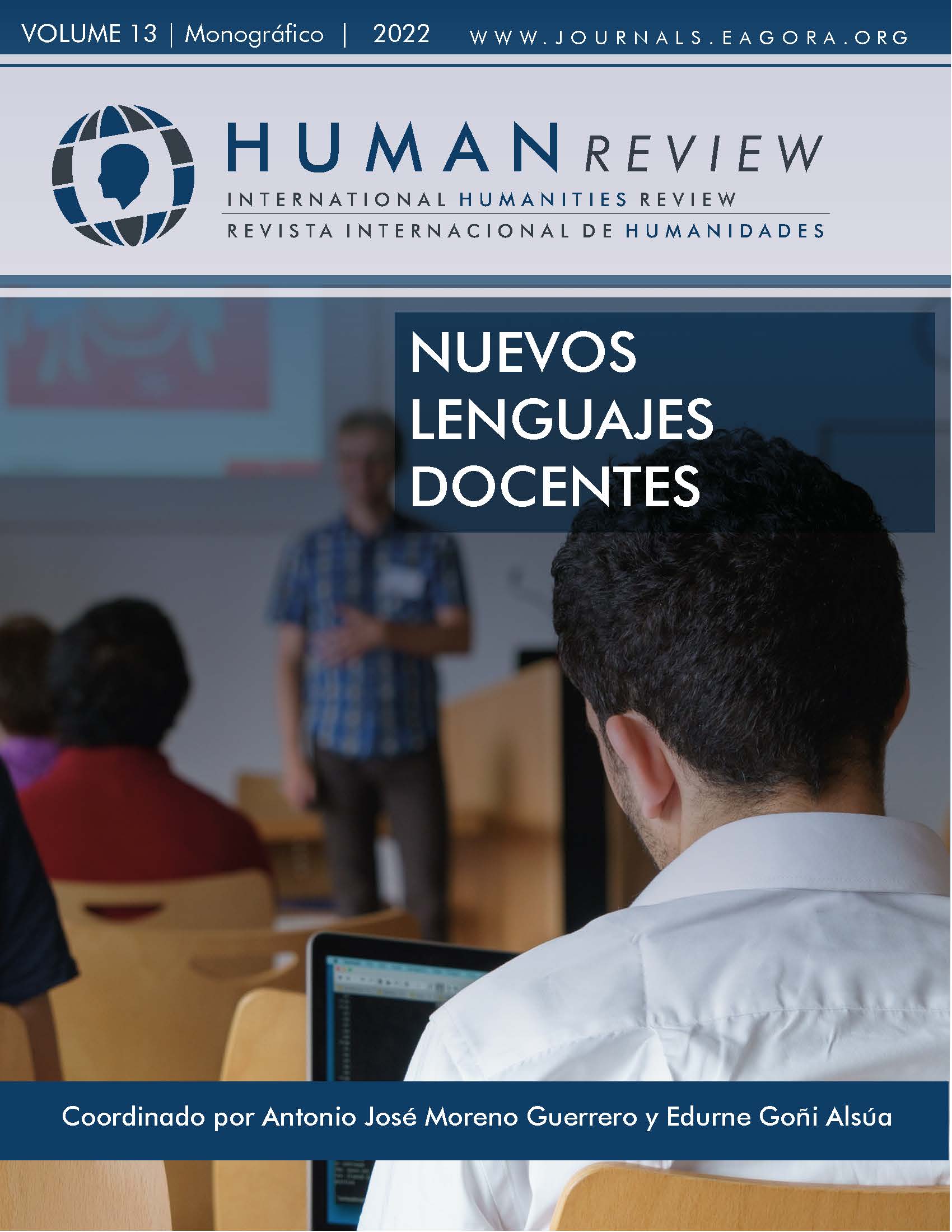Gifted high school students, research on their creativity
DOI:
https://doi.org/10.37467/revhuman.v11.4013Keywords:
Creativity, Dimensions, Gifted, High school, StudentsAbstract
Creativity, a construct that has been raised from different perspectives throughout history and is defined, measred and interpreted by different authors. This article aisms to study how creativity Works in fifted students. To do this, two instruments are applied, two test, which are contrasted, to analyze the dimensions of creativity to a sample of secondary school students. The results show differences in favor of students with high ability. The conclusions are that it allows establishing a significant relationship between creativity and gifted students.
References
Aguilar and M. Pifarre Turmo (2019), Promoting Social Creativity in Science Education With Digital Technology to Overcome Inequalities: A Scoping Review, Front. Psychol., vol. 10, Jul. 2019. DOI: https://doi.org/10.3389/fpsyg.2019.01474
Belmonte-Lillo, V. M. B., & Úbeda, A. I. P. (2017). Creatividad y adolescencia: Diferencias según género, curso y nivel cognitivo. EJIHPE: European Journal of Investigation in Health, Psychology and Education, 7(3), 177-188. DOI: https://doi.org/10.30552/ejihpe.v7i3.205
Castelló, A. y Batlle, C. (1998). Aspectos teóricos e instrumentales en la identificación del alumno superdotado y talentoso. Propuesta de un protocolo. FAISCA, 6, 26-66.
Duke, Creativity in science, in J. Chem. Educ., vol. 49, no. 6, pp. 382–284, 1972. DOI: https://doi.org/10.1021/ed049p382
Guilford, J.P(1950) “Creativity,” Am. Psychol., vol. 5, pp. 434–444, DOI: https://doi.org/10.1037/h0063487
Hu, W. & Adey, P. (2002). A scientific creativity test for secondary school students. International Journal of Science Education, 24(4), 389-403. DOI: https://doi.org/10.1080/09500690110098912
Kaufman J. C., Beghetto, RA (2009) “Beyond Big and Little: The Four C Model of Creativity,” Rev. Gen. Psychol., vol. 13, DOI: https://doi.org/10.1037/a0013688
Millán Gutiérrez, M.A. (2020). Altas Capacidades y Creatividad: un estudio empírico en adolescentes de un centro educativo. Tesis doctoral. Universidad Internacional de la Rioja.
Perry, (2015) “Creativity in Theoretical Physics,” in Creativity and Innovation Among Science and Art, Springer, Ed. London, pp. 99–111. DOI: https://doi.org/10.1007/978-1-4471-6624-5_5
Renzulli, J. S. (1978). What makes giftedness? Reexamining a definition. Phi Delta Kappan, 60, (3), 180-184, 261.
Rhodes, M (1961). “An analysis of creativity,” Phi Delta Kappan, vol. 42, no. 7,
Ruiz, M. J., Bermejo, R., Ferrando, M., Prieto, M. D., & Sainz, M. (2014). Inteligencia y Pensamiento Científico-Creativo: Su convergencia en la explicación del rendimiento académico de los alumnos. Electronic Journal of Research in Educational Psychology, 12(2), 283-302. DOI: https://doi.org/10.25115/ejrep.33.13122
Ruiz, M.J. (2017). Estudiar los perfiles creativos de los estudiantes en los distintos ámbitos escolares de la Educación Secundaria. Tesis Doctoral. Universidad de Murcia. http://hdl.handle.net/10201/55711
Sternberg, R. J. (2005). The WISC model of Giftedness, en R. J. Sternberg and J. E. Davidson. Conceptions of giftedness (pp. 327-342). Cambridge: University Press.
Sternberg, R. J. (2007) Creativity as a habit, in Creativity: A handbook for teachers, pp. 3-25. DOI: https://doi.org/10.1142/9789812770868_0001
Torrance, R.P. (1963. Creativity. Washington, D.C.: National Education Association.
Torrance, E. P. (1965). Cómo es el niño sobredotado y cómo enseñarle. Buenos Aires: Paidós. Cfr. Torrance, E. P. (1974). The Torrance Tests of Creative Thinking - Norms-Technical Manual Research Edition - Verbal Tests, Forms A and B - Figural Tests, Forms A and B. Princeton NJ: Personnel Press
Torrance, E. P. (1980). Lessons about giftedness and creativity from a nation of 115 million overachievers. Gifted Child Quarterly, 24, (1), 10–14. DOI: https://doi.org/10.1177/001698628002400103
Torrance, E. P. (1984). The role of creativity in identification of the gifted and talented. Gifted Child Quarterly, 28, (4)153–156. DOI: https://doi.org/10.1177/001698628402800403
Wallas,G (1926). The art of Thought. New York: Harcourt Brace, Hernández, D. (2010). Alta habilidad y competencia experta. Tesis Doctoral. Murcia: Universidad de Murcia.
Pfeiffer, S. I. (2002). Identifying gifted and talented students: Recurring issues and promising solutions. Journal of Applied School Psychology, 19, 31- 50.
Pfeiffer, S. I. (2003). Identifying gifted and talented students: Recurring issues and promising solutions. Journal of Applied School Psychology, 19, 31- 50. DOI: https://doi.org/10.1300/J370v19n01_03
Pfeiffer, S. I. (2015). El Modelo Tripartito sobre la alta capacidad y las mejores prácticas en la evaluación de los más capaces: Tripartite Model of Giftedness and Best Practices in Gifted Assessment. Revista de Educación 368,66-95.
Pfeiffer, S. I. (2017). Identificación y evaluación del alumnado con altas capacidades: Una guía práctica. Edición y traducción Javier Tourón y Roberto Ranz.144-156 Logroño. UNIR.
Ranz &Tourón, (2017). Características del alumnado con altas capacidades: Algunas pistas para su identificación y evaluación del alumnado con altas capacidades. Una guía práctica (pp: 101-137). Edición y Traducción de Tourón, J y Ranz, R. Logroño: UNIR
Sternberg, R. (1997) Inteligencia exitosa: Cómo una inteligencia práctica y creativa determinan el éxito en la vida. Barcelona: Paidós
Sternberg, R. J. (1985). Beyond IQ: A triarchic theory of human intelligence. New York: Cambridge University Press. (Traducción Más allá del cociente intelectual. Una teoría triárquica de la inteligencia humana. Bilbao: Desclée de Brouwer, 1990).
Sternberg, R. J. (2001). Giftedness as developing expertise: A theory of the interface between high abilities and achieved excellence. High Ability Studies, 12, DOI: https://doi.org/10.1080/13598130120084311
Sternberg, R. J. (2005). The WISC model of Giftedness, en R. J. Sternberg and J. E. Davidson. Conceptions of giftedness (pp. 327-342). Cambridge: University Press. DOI: https://doi.org/10.1017/CBO9780511610455.019
Sternberg, R.J.& Lubart, T. I. (1995). Defying the crowd. Cultivating creativity in a culture of conformity. New York: Free Press. (Traducción. La creatividad en una cultura conformista: un desafío a las masas. Barcelona: Paidós, 1997).
Tourón, J. (2020). Las Altas Capacidades en el sistema educativo español: reflexiones sobre el concepto y 15 la identificación. Revista de Investigación Educativa, 38(1), 15-32.DOI: http://dx.doi.org/10.6018/rie.38.1.396781 DOI: https://doi.org/10.6018/rie.396781
Wechsler, D. (2014). WISC-V, Escala de inteligencia de Wechsler para niños-V. Madrid: Pearson
Downloads
Published
How to Cite
Issue
Section
License
Those authors who publish in this journal accept the following terms:
- Authors will keep the moral right of the work and they will transfer the commercial rights.
- After 1 year from publication, the work shall thereafter be open access online on our website, but will retain copyright.
- In the event that the authors wish to assign an Creative Commons (CC) license, they may request it by writing to publishing@eagora.org









